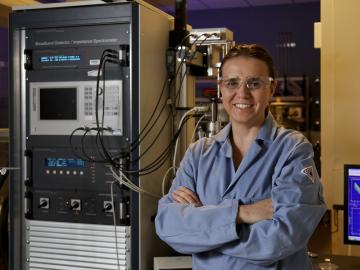
Filter News
Area of Research
- (-) Energy Science (84)
- (-) Materials (86)
- (-) Neutron Science (39)
- Advanced Manufacturing (1)
- Biological Systems (1)
- Biology and Environment (70)
- Biology and Soft Matter (1)
- Computational Biology (2)
- Computational Engineering (2)
- Computer Science (3)
- Electricity and Smart Grid (3)
- Energy Frontier Research Centers (1)
- Functional Materials for Energy (1)
- Fusion and Fission (12)
- Fusion Energy (8)
- Isotopes (8)
- Materials for Computing (10)
- Mathematics (1)
- National Security (24)
- Nuclear Science and Technology (15)
- Nuclear Systems Modeling, Simulation and Validation (1)
- Quantum information Science (2)
- Sensors and Controls (2)
- Supercomputing (87)
News Topics
- (-) Advanced Reactors (9)
- (-) Biomedical (23)
- (-) Grid (40)
- (-) Mathematics (3)
- (-) Nanotechnology (45)
- (-) Physics (30)
- (-) Security (8)
- (-) Summit (9)
- 3-D Printing/Advanced Manufacturing (92)
- Artificial Intelligence (16)
- Big Data (8)
- Bioenergy (34)
- Biology (19)
- Biotechnology (5)
- Buildings (38)
- Chemical Sciences (35)
- Clean Water (11)
- Composites (19)
- Computer Science (42)
- Coronavirus (23)
- Critical Materials (19)
- Cybersecurity (11)
- Energy Storage (88)
- Environment (67)
- Exascale Computing (3)
- Fossil Energy (3)
- Frontier (4)
- Fusion (8)
- High-Performance Computing (11)
- Hydropower (3)
- Irradiation (1)
- Isotopes (13)
- ITER (1)
- Machine Learning (12)
- Materials (100)
- Materials Science (99)
- Mercury (3)
- Microelectronics (1)
- Microscopy (29)
- Molten Salt (3)
- National Security (7)
- Neutron Science (128)
- Nuclear Energy (23)
- Partnerships (16)
- Polymers (22)
- Quantum Computing (4)
- Quantum Science (16)
- Simulation (4)
- Space Exploration (8)
- Statistics (1)
- Transportation (72)
Media Contacts

A new method developed at Oak Ridge National Laboratory improves the energy efficiency of a desalination process known as solar-thermal evaporation.

Scientists have discovered a way to alter heat transport in thermoelectric materials, a finding that may ultimately improve energy efficiency as the materials

An ORNL-led team's observation of certain crystalline ice phases challenges accepted theories about super-cooled water and non-crystalline ice. Their findings, reported in the journal Nature, will also lead to better understanding of ice and its various phases found on other planets, moons and elsewhere in space.

Scientists at Oak Ridge National Laboratory have developed a low-cost, printed, flexible sensor that can wrap around power cables to precisely monitor electrical loads from household appliances to support grid operations.

OAK RIDGE, Tenn., March 20, 2019—Direct observations of the structure and catalytic mechanism of a prototypical kinase enzyme—protein kinase A or PKA—will provide researchers and drug developers with significantly enhanced abilities to understand and treat fatal diseases and neurological disorders such as cancer, diabetes, and cystic fibrosis.


Vera Bocharova at the Department of Energy’s Oak Ridge National Laboratory investigates the structure and dynamics of soft materials.

More than 1800 years ago, Chinese astronomers puzzled over the sudden appearance of a bright “guest star” in the sky, unaware that they were witnessing the cosmic forge of a supernova, an event repeated countless times scattered across the universe.

OAK RIDGE, Tenn., Feb. 8, 2019—The Department of Energy’s Oak Ridge National Laboratory has named Sean Hearne director of the Center for Nanophase Materials Sciences. The center is a DOE Office of Science User Facility that brings world-leading resources and capabilities to the nanoscience resear...
![Coexpression_hi-res_image[1].jpg Coexpression_hi-res_image[1].jpg](/sites/default/files/styles/list_page_thumbnail/public/Coexpression_hi-res_image%5B1%5D_0.jpg?itok=ww635BCP)
While studying the genes in poplar trees that control callus formation, scientists at Oak Ridge National Laboratory have uncovered genetic networks at the root of tumor formation in several human cancers.


